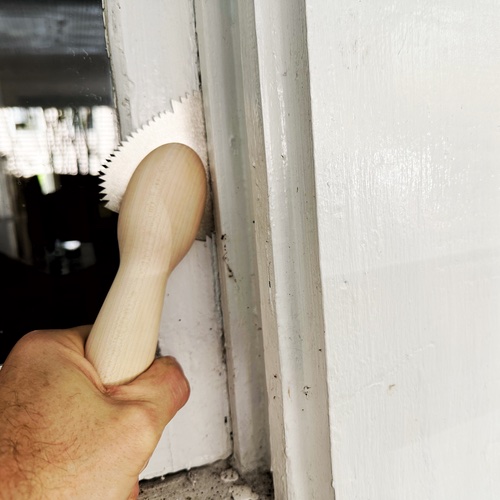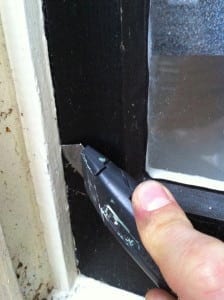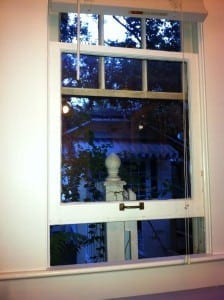
If you’ve got an old house then you’ve probably got a stuck window. Over the years, numerous coats of paint by lazy painters and slapdash landlords have typically sealed shut most windows on a historic home. But, you don’t have to live with that anymore. If it’s just a few coats of paint standing between you and some fresh air, then I can show you how to get things moving again.
The Tools
You don’t need a lot of tools for this project but here are the few that I use and recommend to get the job done right.
Step #1 Inspect Sash Cords
To determine if it is paint that’s the cause of your problems, we’ll need to check a few things. First, make sure the sash cords are still in working order. Pull on them to see if they are still attached to the sash weights in their pockets.
If the pulleys turn and you can feel the tension from the sash weights, then you’re probably in good shape. If the cords are missing or they are no longer attached to the weights, then you’ll need to re-rope the sash after cutting it free. You can learn how to do that in this post, How To: Broken Replace Sash Cords.
 Step #2 Free The Interior
Step #2 Free The Interior
Most old windows have been painted shut on both the exterior and interior, so let’s start with the interior. Use the razor knife to draw a straight line between the sash and window stops on both sides. Then, hammer your 10-in-1 into the space along the line to gently break the bond wiggling it a bit.
You can avoid the cutting and prying by using a handy tool called a Sash Saw that is designed to saw thru the paint line and clear out this troublesome joint. You can see a Sash Saw pictured in the top picture of this post.
Next, do the same at the meeting rail (where the top and bottom sash meet when in the closed position.) You’ll need to have the sash lock unlocked in order to separate the two sashes.
Step #3 Free The Exterior
Do the same thing as the interior, except this time, you’ll be cutting between the sash and the parting bead (which is the square trim piece just outside of the sash.)
Then, move on to the underside of the meeting rail. After that, don’t forget to cut the paint and use your putty knife at the bottom of the sash where it meets the window sill. All these areas can also be cut using the Sash Saw as it’s designed to run flat against the surface while cutting the paint.
Step #4 Open Your Window
Now, head back inside and slowly try to wiggle the window open. If it is still stubborn, keep using your tools to clean out the remaining paint from the joints that present an issue.
Once you get it moving a bit, gently keep opening and closing the window. It will continue to slide easier and easier. You can also add some Window Wax to the sides of the jamb and sash to help it slide smoother.
If you looking to go further and remove the sash for restoration then check out the video below to watch how both the top and bottom sash can be removed and made to both operate smoothly.

Founder & Editor-in-Chief
I love old houses, working with my hands, and teaching others the excitment of doing it yourself! Everything is teachable if you only give it the chance.




my problem window is totally different in material and issue. I just had new vinyl double pane window installed (by a community service that assists people in need) and the problem is I cannot close the window without hurting myself. Once it is open, which I do by sliding to the left…….when I try to slide it to the right to close, it FEELS as though it is spring loaded ; and as though it is fighting me to spring back to the open, left position. Do you have any idea what could cause this ?
Very helpful site!! I have metal windows which I am not able to replace. Because the exterior had accumulated some overspray and weathering, I had someone paint them last year with metal paint from Sherwin-Williams – they look great!! BUT I just tried to open one and realized they were painted shut.
Can you advise whether the steps you suggested for wooden windows will also work? If so, are there any modifications necessary because the frames are metal? If not, any suggestions?
Thanks,
Mary
Mary, try my post that specifically discusses steel windows. There isn’t really a specific way to cut those free other than just cutting around the perimeter of the moveable sash.
https://thecraftsmanblog.com/how-to-restore-steel-windows/
I love your site! It has been so helpful to me. I just bought a 1939 house that has wood windows with wire inside instead of sash cords. The bottom of the windows open surprisingly well, and it appears there are only a few coats of paint. The top halves don’t move at all. Before I go cutting into them to try to free them, how do I tell for sure that they ARE double hung windows? The house was not super fancy when it was made. Is it possible they are just single hung windows? I don’t want to damage all the paint and make work for me if they aren’t actually operable. But if they are, then I do want to get them open, as I love double hung windows for the air circulation. Thanks for any advice you can give.
Great post! I’ve been living in my home for 11 years and thought I needed to get a couple of men over here to open the windows (because that is how the only one got opened 11 years ago). However, my little 5 foot 100 pound self did it. I just rubbed ivory soap on the rails to help it all glide very well.
Way to go Kristy!
After cutting the sides inserted tip of blade of hand ax gently tapped with hammer and repeated on other side and bottom. Took more time cleaning and cutting old paint away.
I recently moved into a 1920’s bungalow in San Antonio. The windows are caulked and painted shut and there are screens on the outside of the windows which are locked in place. No way to remove the screens without opening the window, and no way to open the window without cutting around it from the outside which would require removing screens. Ideas?
Julie, it will take some more elbow grease but you can get those sashes moving again by cutting the insides free and not the outside usually. Or you’re left with the option of cutting the screening in order to get the hook and eye off the sill to remove the screen and give you access to the sashes. May the force be with you!
Great post and very informative. Window cleaners are often confronted with this problem of stuck windows. most of the time, they just move on without trying to fix it. But these tips definitely help if you want to try and open so you can clean them. Thanks for the info!
I just purchased a 1929 Bungalow with a couple modern updates but all original windows are still in place. This was a great tutorial on how to free them from the layers and layers of heavy thick paint that previous owners applied. Everyone is telling me to update them to vinyl but I can’t and won’t part with them. Only two have broken cords which I plan on replacing myself. Will be reading everything you have on this website.
Thanks Maggie! Happy to help!
Hi just found your very informative site while trying to make my 1935 homes windows operable again. Was thinking they were just painted shut but then thought maybe they were also missing pulleys. One window (over kitchen sink) has visible pulleys still attached to weights but all the other tall double hung windows in house do not. They all do have spring locks that it appears you would have to pull in on both sides of the window while sliding up, until they lock into a hole that only exists on the right side of the frame higher up. Do these types of windows require pulleys too that are missing, or no?
Slicing through the paint on the inside of the windows hasn’t allowed the windows to open yet. But haven’t had a chance to remove the aluminum screen windows that have been placed over all the exterior, so that I can slice through the exterior paint, but it appears it will be necessary to get any of these windows working again!
Any thoughts would be greatly appreciated!
The spring locks are usually used in place of pulleys so once the paint is all cut free you should be able to pull the springs inward and operate the window.
Hi,
I have a home built in 1833, and I am trying to get the window to stay open without propping it up. I don’t see any cords or pulleys on these windows? Any suggestions?
I have the same problem. I use a piece of pvc quarter round trim. Wish I didn’t have to.
Moved yo a house where the windows have been sealed shut with furniture glue How can I get them opened Please
No trick to it other than a lot of elbow grease and the steps I talk about here. One tip, if you can is to maybe try steam to soften the glue.
Dear Scott,
I have casement windows that roll out. One window i am unable to open. It is not painted stuck, my house is brick. This is a picture window made up of 4 windows, the windows on each end are able to open. Only one does. The screen which fits on the inside of the window no longer fits. Is this due to house settlement or the wood window frame warping? Can thisbe fixed?
Elaine, it could be either settling or warping of the wood. The simplest solution is to pry the window open and plane down the sides that are too large to fit anymore until you get smooth operation back.. No trick to it just trial and error until you find the right fit.
I have an issue. I was using Flex Seal where the glass met the metal on the sliding door while it was open. Somehow the door itself is stuck…..closed. How can I pry the door open?
I’m not familiar with Flex Seal. Sorry I can’t be of help.
When ever you use any spray mastic or anything like Flex Seal ALWAYS ALWAYS mask off what you don’t want it to get on.
If it is a wooden door remove stops and use a window zipper to attempt to release the door from the glue like substance. If that doesn’t work, I am lost as to how to open your door without taking it apart totally. But when you figure it out, post your method here and on the Flex Seal site. It’s great stuff, but you have to be very careful not to let the item you have sprayed touch anything else for some time. I have a newly ‘Sealed’ plastic watering can that is now a permanent planter on my patio.
I reread your post and see that it is metal. If you have a small pry bar (adding padding), very carefully pry slightly along the length of the door. It may not be stuck the full length.
I have a few push out windows that appear to have some kind of plaster on them on the out side of the window which prevents the window from opening out. What can I use to open them without damaging the wood frame and be able to take advantage of the window or replacing it?
It’s hard to tell what you’re dealing with here. Send me a picture at Scott @ thecraftsmanblog.com and I’ll see what I can do.
I live in a tenement flat and so can’t get out to free the exterior. Is there a way that I can try to do this from the inside?
Alex it depends on how much paint is on the outside. You might be able to, but it usually requires access to the outside where the bulk of the paint and caulk has been applied.
In a tenement, you need to look at freeing up the parting bead to work the top sash free from the inside. They’re only held in by friction and paint. With the parting beads removed you can pull the lower edge of the top sash towards you, which along with cutting paint from the inside and parts you can safely reach outside, is often enough to free it up.
You’ll need to remove one of the staff beads and bring the lower sash in first. This is often made easier if it is already fitted with ‘simplex’ hinges and releases for cleaning, e.g. in Scotland.
Parting beads can be brittle. People often factor on replacing them. If your tenement is ~1860s or later they are usually a standard size and you can buy modern ones with draft excluding brushes easily.
Once the lower sash and parting beads are removed, you will be able to open the sash pockets on the side, and check that the sash weights for the top sash are still attached. If neither weight is attached, hanging from a cord in the pockets for the top sash (i.e. not the weight directly inside the pocket, but the one beyond that towards the outside world) then you will need to free the top sash with great care to stop it falling and damaging you or the window.
my problem is a push out window I am trying a similar effort such as yours tonite I have tried silicone now I am trying WD 40 This window has been fine since I moved here 4 years ago I painted outside windows last summer
Works great! Thank you. I had tried a putty knife alone before on our crank-out windows, with no luck. Thank you for the box-cutter idea, along with the pic of the right one.
Hi Scott,
The weight pockets were very hard to open. I found this post and understood why! http://mnwindowrestoration.wordpress.com/2012/01/29/open-weight-pocket-door-from-top/
The kerfs were made when the jamb was in place and the cuts were not completely clean. I used a hammer and putty knife to seperatel the wood on the vertical kerf as well on the horizontal kerfs. I needed a few size flathead screwdrivers, awls and a mini crow bar to crack them open. A mega pain but finally repaired 2 window sash cords and they are back to working order ! 🙂
They are often only partially cut thru Kelly, but sometimes they are a royal pain like in your case. Way to get it done!
Hi Scott, my husband and I own a 1921 Craftsman which has every single original window. I’ve begin to restore and repair the ones that have broken sash cords etc. One thing is I can’t seem to open the weight pocket once the stops and sash are removed. Do you have any tips or tricks on how to pop the wooden door open? Thanks 🙂
Kelly, the pocket doors are going to be either screwed into place or occasionally the are nailed. Remove the screw if it is present and then you’ll have to pry the door open. The doors weren’t always cut all the way thru so it sometimes require some muscle to pry it off the first time. And remember each door is unique and will only fit back where it came from. Be careful not to mix them up! Good luck!
This window likely has lead-based paint. Be safe and follow epa.gov/lead instructions so you don’t poison pregnant women, kids or pets with toxic dust or vapors.
Well it sure helps to know how to open up those paint sealed windows. A friend of mine had to hire professionals to do all of these for her but it sounds pretty simple so thanks for the tips. Nothing can enhance a home more than having pretty windows that you can actually use.
Jennifer – Glad to help! Yeah, if you’ve got a DIY spirit you can tackle most of the smaller historic window repairs on your own. Which is probably best because unless you find a historical specialist in your area most contractors don’t have a clue what to do with these windows. Send us some pictures when you finish!